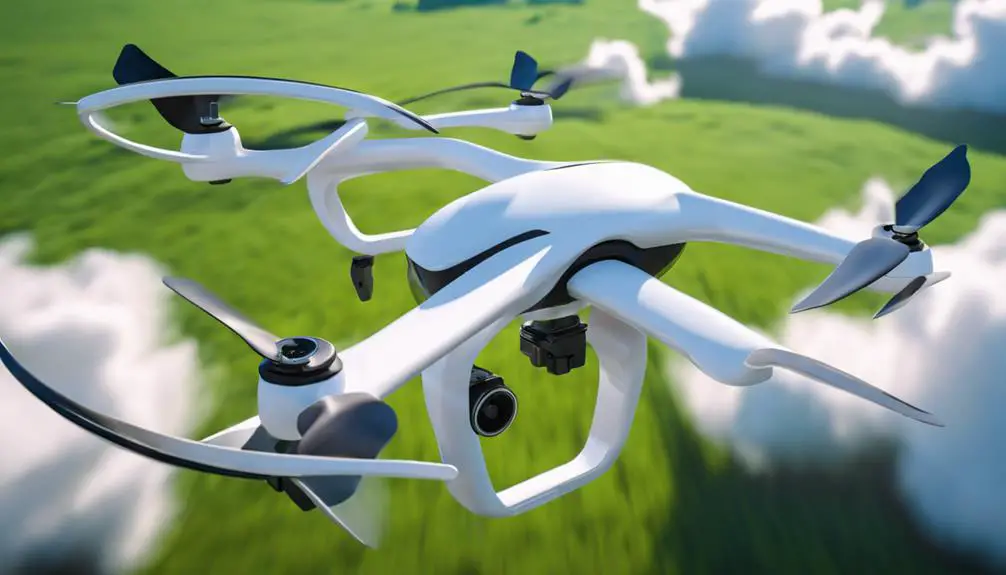Drones can fly at varying speeds, typically ranging from 15 mph to a thrilling 100 mph. Aerial photography drones usually cruise around 15-25 mph to capture steady shots, while racing drones are built for performance and can reach speeds of up to 100 mph. Delivery drones often operate between 30-40 mph, balancing speed with precision. The speed you experience will depend on the drone's design, weight, and motor power. Understanding these factors can greatly enhance your flying experience. If you're curious about specific drone types and their capabilities, there's plenty more to explore.
Types of Drones
There are several types of drones, each designed for specific purposes and applications. If you're looking for freedom in aerial exploration, consider quadcopters; they're perfect for beginners and hobbyists. For those interested in photography or videography, camera drones offer stunning visuals from above. If you're into racing, racing drones can provide an exhilarating experience with their agility and speed. Meanwhile, fixed-wing drones are ideal for longer flights and greater distances, suitable for mapping or surveying. And let's not forget about agricultural drones, which help farmers monitor crops efficiently. Each type caters to unique needs, empowering you to choose the right tool for your adventures. Embrace the possibilities and let your spirit of exploration soar!
Speed Comparisons
When exploring the various types of drones, it's important to contemplate their speed capabilities, as this can greatly impact your flying experience and the effectiveness of your chosen application. For instance, racing drones can reach speeds up to 100 mph, giving you the thrill of competition and the freedom to maneuver quickly. In contrast, aerial photography drones typically cruise around 15-25 mph, allowing for stable shots without the rush. If you're into delivery drones, they often zip along at 30-40 mph, balancing speed and precision. Understanding these comparisons helps you choose the right drone for your needs, whether you're seeking adrenaline or just wanting to capture stunning views. Ultimately, knowing a drone's speed empowers you to maximize your adventures.
Factors Affecting Speed
Several factors can influence a drone's speed, including its design, weight, and the type of motors used. If you're looking for freedom in flight, consider how aerodynamic shapes can reduce drag, allowing your drone to zip through the air more efficiently. Heavier drones might struggle to reach higher speeds, so finding the right balance between stability and weight is essential. Additionally, the motors play a pivotal role; more powerful motors can provide that extra thrust, giving you the freedom to explore faster. Battery life also matters; a drained battery won't just slow you down but could ground you. By understanding these factors, you can optimize your drone for ultimate speed and a thrilling flying experience.
Racing Drones
Racing drones are specifically designed for speed and agility, allowing you to navigate through tight courses and obstacles with precision. These high-performance machines can reach speeds upwards of 100 mph, giving you the exhilarating freedom to push your limits. Here's a quick comparison of key features:
| Feature | Racing Drones |
|---|---|
| Speed | 100+ mph |
| Weight | 250-400 grams |
| Battery Life | 3-10 minutes |
With lightweight frames and powerful motors, racing drones offer an unmatched thrill. You'll feel the rush as you zip around tracks, competing against others or just enjoying the experience. So, if you crave speed and excitement, racing drones are your ticket to a world of aerial freedom.
Aerial Photography Drones
Designed for capturing stunning visuals, aerial photography drones prioritize stability and image quality over sheer speed. When you're up in the sky, you want to make the most of your freedom to explore and document breathtaking landscapes. These drones often feature advanced gimbals, ensuring your shots are smooth and clear, even in windy conditions. You'll find that many models can hover steadily, allowing you to frame the perfect shot without the rush. With impressive camera capabilities, you can capture high-resolution images and stunning 4K video. Whether you're shooting a sunset or a sprawling cityscape, these drones give you the creative freedom to express your vision from above. So, grab your drone and let your imagination soar!
Regulations and Limitations
When flying a drone, it is crucial to understand the regulations and limitations that govern their use to guarantee both safety and compliance. Ignoring these rules could lead to fines or worse, so you'll want to stay informed. Here's a quick reference to help you navigate the basics:
| Regulation Type | Description | Example |
|---|---|---|
| Height Restrictions | Maximum altitude for flight | Usually 400 feet |
| No-Fly Zones | Areas where drones can't operate | Airports, military bases |
| Registration | Requirement for drone registration | Required for drones over 0.55 lbs |
| Visual Line of Sight | Must keep the drone within sight | No flying behind buildings |
Embrace the freedom of flying, but remember to respect the guidelines that keep everyone safe!

